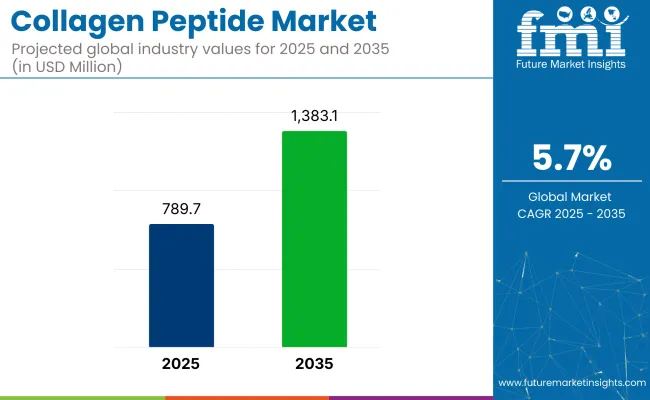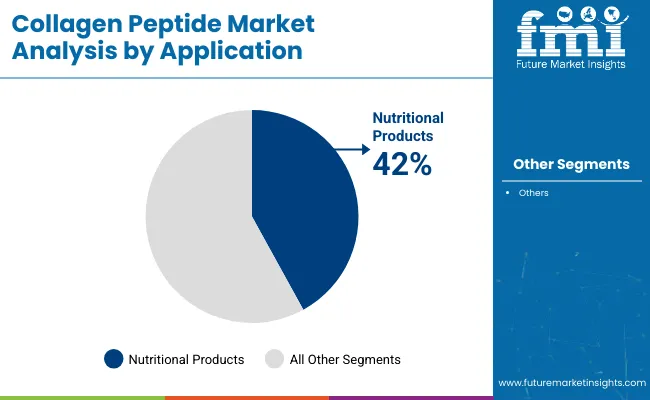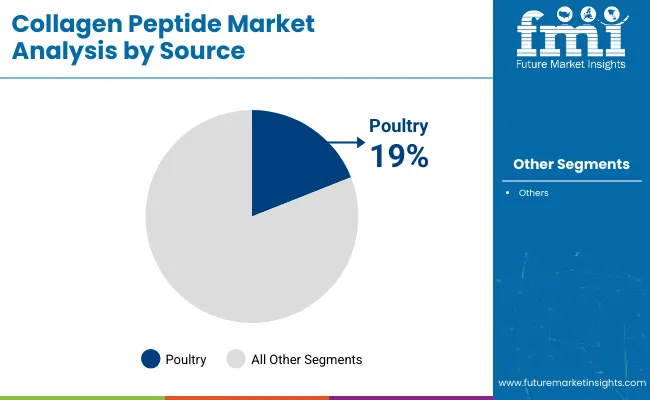The global collagen peptide market is valued at USD 789.7 million in 2025 and is expected to reach USD 1,383.1 million by 2035, reflecting a CAGR of 5.7%. Growth is expected to be driven by increasing demand for health and wellness products, the expansion of nutraceutical applications, and the rising popularity of marine and poultry-based collagen sources due to bioavailability and sustainability benefits.

| Metric | Values |
|---|---|
| Estimated Size (2025E) | USD 789.7 million |
| Projected Value (2035F) | USD 1,383.1 million |
| CAGR (2025 to 2035) | 5.7% |
Moreover, the market is anticipated to benefit from the rapid adoption of collagen peptides in functional foods and beverages aimed at improving joint health, skin elasticity, and muscle repair.
In 2025, the USA is likely to hold the largest market share, expanding at a CAGR of 5.8%. Meanwhile, Japan is projected to witness growth with a CAGR of 5.1%, followed closely by the UK at 4.9%. Within application segments, nutritional products are set to dominate with a 42% of the market share, driven by supplements and functional foods. Meanwhile, the dry form of collagen is expected to dominate the form segment with a prominent market share of 73%.
The market accounts for a small but growing share within its parent markets. It is estimated to represent approximately 3-4% of the global protein ingredients market, driven by its specialized functional benefits. Within the nutraceutical ingredients market, collagen peptides hold around 5-6% share, mainly due to their integration into beauty and joint health supplements.
In the food & beverage ingredients market, the share is relatively low at below 1%, given the broader scope of this sector. However, collagen peptides are increasingly capturing a notable proportion within the cosmeceuticals market, accounting for approximately 8-10% share due to high demand for anti-aging applications.
The global market is segmented by application type, source, form, and region. By application type, it includes nutritional products, cosmetics & personal care products, food & beverages, and pharmaceuticals. By source, it is segmented into marine & poultry, bovine, and porcine.
By form, it is segmented as dry and liquid. By region, it covers North America, Latin America, Western Europe, Eastern Europe, Balkans & Baltic, Russia & Belarus, Central Asia, East Asia, South Asia & Pacific, and Middle East & Africa.
Nutritional products are anticipated to remain the most lucrative application segment owing to their extensive usage in supplements, protein bars, and functional beverages, accounting for a 42% market share by 2035. This growth is driven by rising consumer preference for protein-rich diets and collagen’s benefits for joint health and skin elasticity.

Marine & poultry sources are projected to experience the fastest growth, capturing a market share of 19% by 2035. Their rise is attributed to consumer preference for non-bovine sources driven by sustainability, dietary restrictions, and superior bioavailability. Sustainable and non-mammalian sources preferred

Dry form is set to dominate the market with a share of 73% by 2035 due to its stability, easy transportation, and extended shelf life. Liquid forms are growing in ready-to-drink nutraceutical beverages, although they pose storage challenges.

Recent Trends in the Collagen Peptide Market
Challenges Facing the Collagen Peptide Market

Between 2025 and 2035, the USA is projected to lead with a CAGR of 5.8%, driven by its strong nutraceutical market and widespread dietary supplement consumption. Japan follows closely with a CAGR of 5.1%, reflecting high demand for beauty and functional beverage applications.
France and the UK are expected to grow at 4.8% and 4.9% respectively, supported by beauty, skincare, and sports nutrition trends. Germany records the lowest growth among these countries at 4.7%, despite its strong pharmaceutical and nutraceutical sectors. Overall, the USA remains the fastest-growing among these top collagen peptide markets.
The report covers an in-depth analysis of 40+ countries; five top-performing OECD countries are highlighted below.
The collagen peptide revenue in the USA is projected to grow at a CAGR of 5.8% from 2025 to 2035. Growth is expected to be driven by rising consumer awareness regarding health, wellness, and anti-aging benefits associated with collagen supplementation. The market is also supported by a mature nutraceutical sector and widespread consumption of dietary supplements. Moreover, the increasing integration of collagen peptides into ready-to-drink beverages and protein bars has broadened its consumer base.
The revenue from the collagen peptide market in the UK is anticipated to rise at a CAGR of 4.9% from 2025 to 2035. Growth will be driven by increasing consumer focus on beauty and skin health, coupled with dietary trends emphasizing protein-rich and clean-label products.
Collagen peptides are being increasingly adopted in nutraceutical formulations targeting joint health and sports recovery. Moreover, regulatory frameworks promoting food safety and ingredient transparency support the market, while online retail platforms continue expanding collagen product accessibility across diverse consumer segments.
The sales of collagen peptides in Germany are estimated to flourish at a CAGR of 4.7% from 2025 to 2035. Growth is expected due to the country’s strong pharmaceutical and nutraceutical sectors, coupled with advanced R&D capabilities supporting product innovation.
German consumers prioritize scientifically backed products, leading to increasing adoption of collagen peptides for joint care and beauty applications.. Stringent quality standards and clean-label preferences drive demand for premium formulations, while collaborations between pharmaceutical companies and research institutions aid market expansion.
The revenue from collagen peptides in France is expected to expand at a CAGR of 4.8% from 2025 to 2035. Growth will be supported by rising consumer focus on beauty, skin care, and overall wellness. Collagen peptides are increasingly being used in premium cosmetic formulations and dietary supplements targeting anti-aging benefits.
The French nutraceutical sector’s emphasis on natural and sustainably sourced ingredients further drives this trend. Market expansion is facilitated by clean-label trends and partnerships between food, pharma, and beauty companies to develop multifunctional collagen-based products.
The collagen peptide market in Japan is predicted to rise at a CAGR of 5.1% from 2025 to 2035. Growth is driven by the cultural emphasis on beauty, youthfulness, and healthy aging. Collagen peptides are widely incorporated into functional beverages, supplements, and beauty products targeting skin elasticity and joint health.
Japanese companies continue to innovate with marine collagen products and ready-to-drink formulations. Additionally, strong marketing strategies combined with consumer trust in collagen’s effectiveness contribute to robust market demand across age groups.
The market is moderately consolidated, with a few global leaders accounting for a significant share of revenues. Tier-one companies such as Darling Ingredients Inc., Gelita AG, and Nitta Gelatin Inc. compete based on product innovation, diversified sourcing, and expansion into personalized nutrition segments. These firms leverage strong R&D capabilities and global supply chains to maintain dominance, while mid-tier players focus on regional markets with specialized offerings in marine and poultry collagen peptides.
Company strategies revolve around sustainable sourcing, advanced extraction technologies, and premium segment targeting in beauty, nutraceutical, and sports nutrition applications. Leading players are investing in clinical research to validate health claims and collaborating with food and pharma companies to launch multifunctional collagen peptide formulations. Strategic acquisitions remain key, enabling firms to strengthen market presence, diversify portfolios, and enhance production capabilities to meet rising global demand.
Recent Collagen Peptide Market News
| Report Attributes | Details |
|---|---|
| Current Total Market Size (2025) | USD 789.7 million |
| Projected Market Size (2035) | USD 1,383.1 million |
| CAGR (2025 to 2035) | 5.7% |
| Base Year for Estimation | 2024 |
| Historical Period | 2020 to 2024 |
| Projections Period | 2025 to 2035 |
| Market Analysis Parameters | Revenue in USD million/Volume in Units |
| By Application Type | Nutritional Products, Cosmetics & Personal Care Products, Food & Beverages, Pharmaceuticals |
| By Source | Marine & Poultry, Bovine, Porcine |
| By Form | Dry, Liquid |
| Regions Covered | North America, Latin America, Western Europe, Eastern Europe, Balkans & Baltic, Russia & Belarus, Central Asia, East Asia, South Asia & Pacific, Middle East & Africa |
| Countries Covered | United States, Canada, United Kingdom, Germany, France, China, Japan, South Korea, Brazil, Australia |
| Key Players | Darling Ingredients Inc., Gelita AG, Nitta Gelatin Inc., Tessenderlo Group, Holista Colltech Limited, Gelnex, BioCell Technology LLC, Italgelatine S.p.A., Ewald-Gelatine GmbH, Kewpie Corporation, Amicogen, Capsugel, Lapi Gelatine S.p.A., Junca Gelatines S.L., Danish Crown |
| Additional Attributes | Dollar sales by value, market share analysis by region, and country-wise analysis |
As per Application Type, the industry has been categorized into Nutritional Products, Cosmetics & Personal Care Products, Food & Beverages, and Pharmaceuticals.
As per Source, the industry has been categorized into Marine & Poultry, Bovine, and Porcine.
As per Form, the industry has been categorized into Dry and Liquid.
Industry analysis has been carried out in key countries of North America, Latin America, Western Europe Eastern Europe, Balkans & Baltic, Russia & Belarus, Central Asia, East Asia, South Asia & Pacific, and Middle East & Africa.
The market size is valued at USD 789.7 million in 2025.
The market is forecasted to reach USD 1,383.1 million by 2035, reflecting a CAGR of 5.7%.
Nutritional products are expected to lead with a 42% share in 2025.
Marine & poultry sources are projected to hold a market share of 19% by 2035.
The USA is anticipated to be the fastest-growing market with a 5.8% CAGR from 2025 to 2035.






Our Research Products

The "Full Research Suite" delivers actionable market intel, deep dives on markets or technologies, so clients act faster, cut risk, and unlock growth.

The Leaderboard benchmarks and ranks top vendors, classifying them as Established Leaders, Leading Challengers, or Disruptors & Challengers.

Locates where complements amplify value and substitutes erode it, forecasting net impact by horizon

We deliver granular, decision-grade intel: market sizing, 5-year forecasts, pricing, adoption, usage, revenue, and operational KPIs—plus competitor tracking, regulation, and value chains—across 60 countries broadly.

Spot the shifts before they hit your P&L. We track inflection points, adoption curves, pricing moves, and ecosystem plays to show where demand is heading, why it is changing, and what to do next across high-growth markets and disruptive tech

Real-time reads of user behavior. We track shifting priorities, perceptions of today’s and next-gen services, and provider experience, then pace how fast tech moves from trial to adoption, blending buyer, consumer, and channel inputs with social signals (#WhySwitch, #UX).

Partner with our analyst team to build a custom report designed around your business priorities. From analysing market trends to assessing competitors or crafting bespoke datasets, we tailor insights to your needs.
Supplier Intelligence
Discovery & Profiling
Capacity & Footprint
Performance & Risk
Compliance & Governance
Commercial Readiness
Who Supplies Whom
Scorecards & Shortlists
Playbooks & Docs
Category Intelligence
Definition & Scope
Demand & Use Cases
Cost Drivers
Market Structure
Supply Chain Map
Trade & Policy
Operating Norms
Deliverables
Buyer Intelligence
Account Basics
Spend & Scope
Procurement Model
Vendor Requirements
Terms & Policies
Entry Strategy
Pain Points & Triggers
Outputs
Pricing Analysis
Benchmarks
Trends
Should-Cost
Indexation
Landed Cost
Commercial Terms
Deliverables
Brand Analysis
Positioning & Value Prop
Share & Presence
Customer Evidence
Go-to-Market
Digital & Reputation
Compliance & Trust
KPIs & Gaps
Outputs
Full Research Suite comprises of:
Market outlook & trends analysis
Interviews & case studies
Strategic recommendations
Vendor profiles & capabilities analysis
5-year forecasts
8 regions and 60+ country-level data splits
Market segment data splits
12 months of continuous data updates
DELIVERED AS:
PDF EXCEL ONLINE
Market Share Insights for Collagen Peptide Providers
Collagen-Boosting Biomimetic Peptides Market Size and Share Forecast Outlook 2025 to 2035
UK Collagen Peptide Market Analysis – Size, Share & Forecast 2025–2035
Fish Collagen Peptides Market Analysis by Source, Application and Region Through 2035
Vegan Collagen Peptides Market Size and Share Forecast Outlook 2025 to 2035
ASEAN Collagen Peptide Market Growth – Trends, Demand & Innovations 2025–2035
Europe Collagen Peptide Market Report – Trends, Size & Forecast 2025–2035
Australia Collagen Peptide Market Insights – Size, Share & Industry Trends 2025-2035
Latin America Collagen Peptide Market Report – Trends, Size & Forecast 2025–2035
Collagen Supplement Market Size and Share Forecast Outlook 2025 to 2035
Collagen Water Market Forecast and Outlook 2025 to 2035
Collagen Skin Matrix Market Size and Share Forecast Outlook 2025 to 2035
Collagen Market Size and Share Forecast Outlook 2025 to 2035
Collagen Drinks Market Analysis - Size, Share, and Forecast Outlook 2025 to 2035
Examining Market Share Trends in the Collagen Casings Industry
Collagen Derivatives Market Analysis by Source, Dosage Form and Application Through 2035
Collagen Gummy Market Analysis by Flavor Type, Source, Functionality, Sales Channel and Region through 2035
Collagen Casings Market Analysis - Product Type & End Use Trends
Collagen Hydrolysates Market Analysis - Size, Share, and Forecast 2024 to 2034
UK Collagen Casings Market Insights – Demand, Size & Industry Trends 2025–2035

Thank you!
You will receive an email from our Business Development Manager. Please be sure to check your SPAM/JUNK folder too.
Chat With
MaRIA